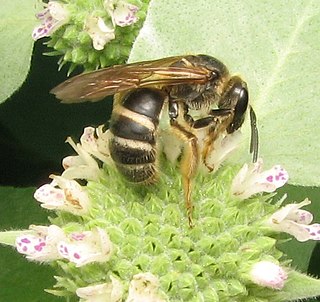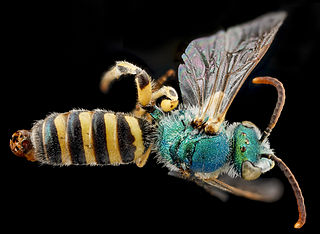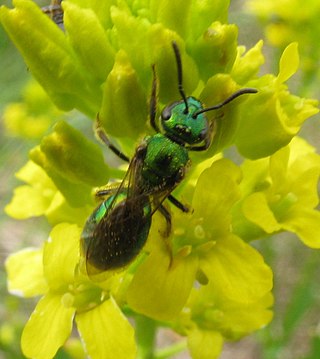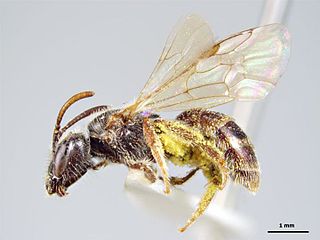
Halictidae is the second-largest family of bees with nearly 4,500 species. They are commonly called sweat bees, as they are often attracted to perspiration. Halictid species are an extremely diverse group that can vary greatly in appearance. These bees occur all over the world and are found on every continent except Antarctica. Usually dark-colored and often metallic, halictids are found in various sizes, colors and patterns. Several species are all or partly green and a few are red, purple, or blue. A number of them have yellow markings, especially the males, which commonly have yellow faces, a pattern widespread among the various families of bees. The family is one of many with short tongues and is best distinguished by the arcuate basal vein found on the wing. Females in this family tend to be larger than the males. They are the group for which the term 'eusocial' was first coined by entomologist, Suzanne Batra.

The sweat bee genus Lasioglossum is the largest of all bee genera, containing over 1800 species in numerous subgenera worldwide. They are highly variable in size, coloration, and sculpture; among the more unusual variants, some are cleptoparasites, some are nocturnal, and some are oligolectic. Most Lasioglossum species nest in the ground, but some nest in rotten logs.

Xyris tennesseensis is a rare species of flowering plant in the family Xyridaceae known by the common name Tennessee yellow-eyed grass. It is native to a small section of the Southeastern United States, including parts of the states of Alabama, Georgia, and Tennessee. A federally listed endangered species, it is threatened by the loss and degradation of its habitat.

Lasioglossum zephyrus is a sweat bee of the family Halictidae, found in the U.S. and Canada. It appears in the literature primarily under the misspelling "zephyrum". It is considered a primitively eusocial bee, although it may be facultatively solitary. The species nests in burrows in the soil.
Marla Spivak is an American entomologist, and Distinguished McKnight University Professor at the University of Minnesota specializing in apiculture and social insects.

Lasioglossum cressonii is a species in the sweat bee genus Lasioglossum, family Halictidae. Halictidae exhibit eusocial hierarchy behavior which is interesting given that eusociality in this group is hard to evolve and easy to lose. L. cressonii is found throughout North America. L. cressonii have been shown to be important pollinators for apple trees and many other North American native plants.

Lasioglossum vierecki, also known as Dialictus vierecki and Halictus vierecki, is a sand sweat bee and is part of the family Halictidae of the order Hymenoptera. It is found in the eastern half of North America from Minnesota to the New England States down to Georgia and Louisiana and up in Manitoba and Ontario. Commonly found in sandy areas, it pollinates various flowers such as grass-leaved goldenrod and rattlesnake master.
Lasioglossum figueresi, formerly known as Dialictus figueresi, is a solitary sweat bee that is part of the family Halictidae of the order Hymenoptera. Found in Central America, it nests in vertical earthen banks which are normally inhabited by one, though sometimes two or even three, females. Females die before their larvae hatch. It was named after José Figueres Ferrer, a famous Costa Rican patriot, and studies of its behavior are now general models for social behavior studies.
Lasioglossum aeneiventre, also known as Dialictus aeneiventre, is a social sweat bee and is part of the family Halictidae of the order Hymenoptera. Found in Central America, it nests mostly on flat ground though sometimes in vertical banks. It is often compared to L. figueresi.

Dialictus is a subgenus of sweat bees belonging to the genus Lasioglossum. Most of the members of this subgenus have a metallic appearance, while some are non-metallic. There are over 630 species worldwide. They are commonly found in the Northern Hemisphere and are found in abundance in North America. Members of this subgenus also have very diverse forms of social structure making them model organisms for studying the social behavior of bees.

Agapostemon angelicus is a species of sweat bee in the family Halictidae native to North America. Unlike apid bees, members of the Halictidae family are not honey-producers, although they still are pollinators.
Lasioglossum albipenne, the white-winged metallic-sweat bee, is a species of sweat bee in the family Halictidae.

Lasioglossum sordidum, also referred to as the small native bee, is one of the smallest native bees found in New Zealand.

Augochloropsis is a genus of brilliant metallic, often blue-green, sweat bees in the family Halictidae. There are at least 140 described species in Augochloropsis.
Lasioglossum subviridatum is a species of sweat bee in the family Halictidae. It is one of the few sweat bees that nests in wood, and thus prefers woodland habitats.

Augochlorella aurata is a primitively eusocial species of sweat bee in the family Halictidae. It is one of three species of Augochlorella found east of the Rocky Mountains in North America. The body is a brilliant green metallic color, diffused to varying extents with a copper, red, or yellow color. A. aurata is a generalist pollen feeder and likely an important pollinator for some horticultural crops. A common name is golden green sweat bee.

Homalictus is a subgenus of bees in the genus Lasioglossum subfamily Halictinae of the family Halictidae. They are found in Sri Lanka, Southeast Asia, east across the Pacific to the Mariana Islands, Samoa, Fiji and are most prevalent in Australia.

Lasioglossum mataroa is a bee species that is found in New Zealand.
Lasioglossum ephialtum is a species of sweat bee in the family Halictidae. A common name is nightmare sweat bee.

John S. Ascher is an American entomologist. He specializes in the study of Apoidea and has been described as "one of the world's leading native bee taxonomists." While they get less publicity than the industrious honeybee, bees indigenous to the Americas play a crucial "role in pollinating crops such as tomatoes, cranberries, alfalfa and squash, experts say. They are often more effective than honeybees as pollinators, and more resistant to problems that have decimated honeybees in the U.S. and Europe, several studies show.”














